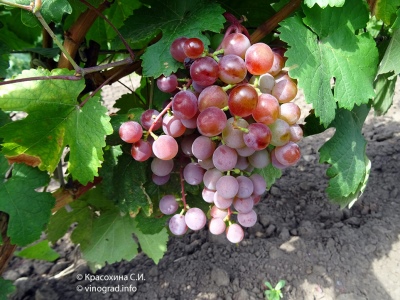
- Authors: A.I. Potapenko
- Appointment: dining room
- Berry color: pink
- Taste: simple, pleasant
- Ripening period: very early
- Frost resistance, ° C: -23
- Bunch weight, g: 350
- Tasting assessment, points: 9
- Density of the bunch: medium density and loose
- Skin: thin
Early maturing varieties of crops are very popular among gardeners. New Russian grapes are just such. In this article, we will consider the characteristics of the variety, yield, ripening time, frost resistance, as well as storage time.
Breeding history
The author of this hybrid is considered to be the breeder Potapenko A.I. Bred in the city of Novocherkassk. The parental pair are the varieties Russian Early and Amursky.
Description
Grapes New Russian belongs to the universal table variety. The bush is low, medium-sized. The vines are spreading, on average, a large bush takes up to 5 m in width.Therefore, it is necessary to plant the seedlings correctly. The vine is brown, strong in structure.
Leaves can be round or heart-shaped in shape, with a noticeable section. There is a slight pubescence on the back of the leaf.
Gardeners note that this variety has good transportability indicators. But culture also has its disadvantages. The small size of the berries is noted, especially during the period of maturation of the bush, approximately the first 2-4 years after planting in the ground. Fruits can begin to crack, lose their juiciness with strong watering, or, conversely, with irregular watering. Therefore, it is worth observing the watering schedule. It is also noted that wasps are very fond of berries, especially when there are cracks on the berries.
Ripening period
As noted above, the variety is early ripe, from the moment of flowering to full ripening of the fruits, 115-120 days pass, depending on the region. Blossoming begins in the first weeks of May, provided the weather conditions are warm.
Bunches
The bunches are not large, there is friability. In order for the brushes to fill up in volume, it is necessary to leave no more than 3 inflorescences on one vine. This is necessary in order for the nutrients to be properly distributed. Otherwise, leaving more inflorescences will take longer to form clusters and require more resources. By weight, one brush stretches 350 g, with proper care, there are clusters weighing 0.8 kg. The shape of the bunch is cylindrical, oblong.
Berries
The berries are medium, there are also small ones. By weight from 3 to 5 g. Shades are dominated by greenish-yellow with pink dusting, or pure pink without any impurities. The shape of the berry is round or slightly elongated-oval. The pulp is juicy, crispy and sugary. The rind is thin, so it cracks easily, but it is not felt when eaten. The fruits are well attached to the stalks, so they will not fall off.
Taste
The taste of New Russian grapes is rich, sweet, there is a slight sourness. The aroma is pronounced with a slight trail of caramel. Therefore, many gardeners call this variety Caramel. Excellent ratio of sugar content 23% to 7% acidity.
Yield
The yield of the hybrid is good, on average, up to 25 kg of berries ripen on one strong and healthy bush with proper care. For the first time, young seedlings yield no more than 5-10 kg per season.
Harvesting takes place in 2 stages. It is worth cutting off the bunches with a sharp pruner. Collection is carried out in dry weather.


Growing features
New Russian grapes do not like excessive moisture. Therefore, it is necessary to select a place that will be protected from the accumulation of excess moisture. This is to prevent the roots of the grapes from rotting. Therefore, many gardeners plant a vineyard on a small artificial hill.
The soil should be loose, sandy and loamy. A large accumulation of clay is not allowed, since it will be difficult for the roots to develop.
The area around the bushes must be periodically loosened to saturate the soil with oxygen.
Landing
An important role is played by the planting of the bushes themselves. Since the bushes are spreading, it is necessary to think over a trellis system for tying the bushes, and also to place the holes correctly.
The pits must be made 0.8 m deep and 0.5 m wide. Broken brick pours out at the bottom of the pit. The bricks will act as drainage. The drainage is then backfilled with a layer of fertile soil along with minerals containing nitrogen. Then a seedling is planted. The seedling is buried neatly, the earth is tamped around. The root collar must be left at a level of 3-5 cm from the ground.
Then the bushes are spilled abundantly with water.
The distance between the bushes is 1.5-2 m, provided that there is a trellis, and between the rows 3 m.

Pollination
The flowers of the grapes are bisexual.
Pruning
In the spring, all dry branches that have not left after an illness are cut off. In the fall, the vine is pruned by 2-3 eyes. All broken and infected branches are removed.



Frost resistance and the need for shelter
The grapes have good frost resistance, -23 degrees. No special shelter is required, since the variety was bred for the northern regions.

Diseases and pests
Wasps are considered the main pests of grapes; they are very fond of grape juice. They attack the plant especially strongly at the end of the season before harvesting.
And also the variety suffers from spider mites and phylloxera.

If a grape is exposed to any disease or insect, this always affects its appearance.
Storage
Stored in a dry and cold place for up to 1-2 months, if the fruits were not cracked.











































































